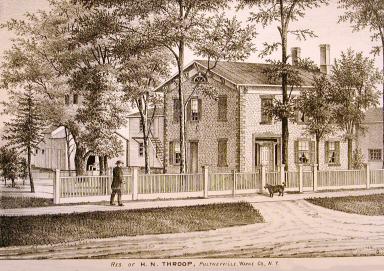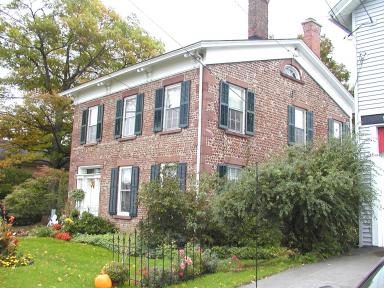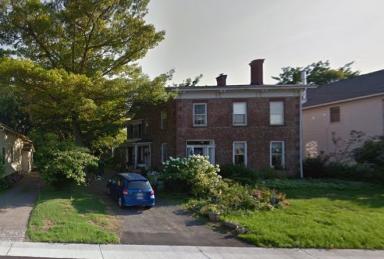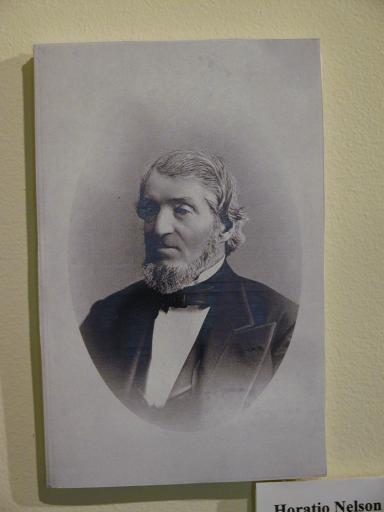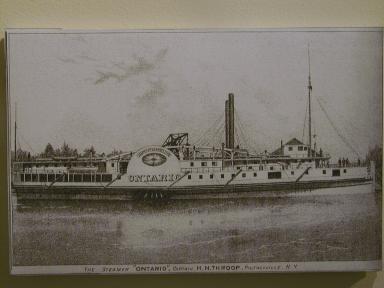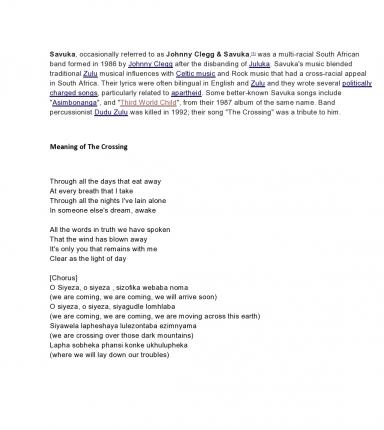If you find errors OR have additional information about this site, please send a message to contact@waynehistorians.org.
Throop-Graeper Cobblestone
| Historic Site #: | 14-020 (Exists) Type: D1,F2 | Town: | Williamson | ||
| Site Name: | Throop-Graeper Cobblestone | GPS Coordinates: | 43.28165, -77.183 | ||
| Address: | 4184 Lake Road. Pultneyville New York | ||||
| Description: | |||||
This three bay cobblestone house was built in 1832 by H.N. Throop, with the help of his brother Washington S. Throop. It is elegant in its simplicity and craftsmanship. Cobblestones are all small in size and reddish in color, set off with cut stone quoins, window caps, a small half-elliptical window in the gable, and a doorway flanked by sidelights, transom, and four simple Roman columns. Six-over-six window panes remain on second story windows. The house stands across the road from Pultneyville’s harbor, where Throop docked his steamboats. The nomination for the Pultneyville Historic District called the H.N. Throop house “a particularly distinguished Federal style dwelling,” “unique in the Pultneyville Historic District for its cobblestone construction and notable for its intact Federal Style entrance detail.” | |||||
| 🔊Audio: Tour Sound Bite for Throop House |
| Historic narrative: | |||||
Discussion: Horatio Nelson Throop was born November 10, 1807, the first European American child to be born in Pultneyville. His father, Samuel Throop, kept the first public house in Pultneyville and also became captain of the first steamship built there, the Laura. Horatio N. Throop followed in his father’s footsteps. According to an obituary, he showed “a taste and determination to become a builder and commander of boats” when he was ten years old. “Designing, drafting, and constructing steamboats, schooners, and smaller boats has absorbed the energies and attention of this ingenious man.” He also invented a screw propeller, although it was never patented. John Ericsson, then living in Oswego, gained credit as inventor of the first screw propeller. On June 3, 1834, Throop married Mary Forman Ledyard, daughter of neighbor Samuel Ledyard and cousin of neighbor Samuel C. Cuyler. Throop became captain of several steamboats, including the Cataract, Bay State, and Ontario. As a major officer in the Ontario Steamboat Company, he was relatively wealthy. “In our little village,” noted his obituary, “he became the one man of abundant means.” Captain H.N. Throop was not active in abolitionist organizations, but he regularly used his position to carry people escaping from slavery from Pultneyville to Canada. Samuel C. Cuyler, Mary Ledyard Throop’s cousin, lived along the lake, a short distance west of the Throop home. Cuyler kept a major station on the Underground Railroad. According to the 1877 History of Wayne County, written when many Underground Railroad participants were still alive, Cuyler and his son Ledyard gathered freedom seekers from William R. Smith in Macedon, Griffith Cooper in Williamson, and William D. Cooke in Sodus. Cuyler would take people escaping from slavery down to the central dock in Pultneyville. Locating Throop, he would say, “Captain Throop, I have some passengers for you.” And Throop would reply, “My boat runs for passengers.” The slaves would be placed on board, [noted the county history], but it is said that when they reached Charlotte [the port on Lake Ontario closest to Rochester], the only point where they could be taken from the boat, there were never any negroes in sight, as they had been secreted. How many slaves were thus helped to Canada by Mr. Culyer and Captain Throop is not known; but, as they were both active men, we know that they were capable of caring for all that came. In 1867, the Ontario Steamboat Company ceased operation, and H.N. Throop retired. In 1870, he was sixty-two years old, and Mary Ledyard Throop was fifty-seven. The census reported that he owned real property worth $20,000 and personal property worth $10,000. Throop had retired as a steamboat captain, but he constructed and sailed his own personal yachts, the Magic and the Swan, “exclusively for his own pleasure and that of those he loved,” noted his obituary. which probably accounted for the high value of his personal property. Although, as a steamboat captain, Throop traveled back and forth across lake Ontario and moved temporarily to Cleveland, Oswego, Rochester, Niagara, and elsewhere, he always maintained his real home in Pultneyville. After spending a day sailing the Swan, H.N. Throop died in this house on the morning of August 6, 1884, age seventy-six, of a heart attack, He was buried in Lakeview Cemetery beside his wife Mary Ledyard Throop. A story that has been handed down..... The Crooked Lake Review Blog MONDAY, MARCH 29, 2010 Throop and the Underground Railroad A day later when the captain had again come out of the post office, Cuyler greeted him once more. Then he asked “Will you be making the run with the Ontarioto to Rochester tomorrow?” Throop nodded. “Then we'll have a cargo for you,” said his friend with a quick wink. Throop glanced at a stranger across the street. The man was leaning on the bridge rail studying the several schooners tied up in the creek. He hadn't expected any fugitives to arrive in Pultneyville so soon. But he answered “Very well. My boat runs for passengers.” The stranger looking over the harbor was a bounty hunter in search of runaway slaves. If he had heard the conversation he gave no sign, and Throop went on his way back home. As he walked down Washington Street, Throop wondered how he would get his “cargo” aboard the Ontario. One or two fugitives could be placed in trunks or crates and carried aboard. But too many large boxes might make the slave catchers suspicious, for Throop's steamer normally did not load much cargo in Pultneyville. Nor could he walk the runaways aboard openly. Cuyler could perhaps distract one bounty hunter, but Throop knew at least three southerners were hanging around the town right now, and that at least one would be watching all the departing ships. Clearly they suspected some “passengers” were about to arrive in Pultneyville on the underground railroad. The slave catchers would collect a large reward for each runaway returned to the south, and anyone caught helping an escaped slave could be fined. It was even possible that the courts could seize his vessel for breaking the law and auction it off. As he considered ways to outwit the bounty hunters, a wagon load of firewood approached. The teamster, Will Murton, pulled up his mules and said “Captain Throop I have your wood for the steamer here. This is the first load. Do you want it stacked on the pier? Throop glanced out at the lake, noting the clear sky and gentle west wind. There would be no bad blows or heavy waves from the east tonight. He said, “Yes, that will be fine.” Then he had a sudden thought. “Hold on a moment, Will. I'd like you to do something a little different with our fuel this time.” Throop looked around for nearby strangers, and then stepped close to the wagon seat and gave Will some odd directions as to how to stack the wood on the pier. Then he walked on to his home. There were seven of them, Peter Butler, his wife Mary, Peter's father, and four other men, all field hands and all from a North Carolina plantation. They'd come north through Philadelphia to New York City and then up the Hudson to Albany where they were given a ride west on the Erie Canal aboard Black Joe's boat. Black Joe was a free black man. He owned his own canal boat and in the past he had smuggled dozens of runaways from Albany aboard it. He had put the group ashore in Palmyra, a day's journey from Pultneyville and the runaways had then come north to Williamson concealed under a wagon load of hay. Here, they spent the night at another “station” on the underground railroad before traveling afoot during darkness with a guide leading them the last five miles to Cuyler's house by the lake. It was now late afternoon and Cuyler and Peter Butler stood on the porch surveying the lake and the little harbor to the west. They were also watching a large steamer, bold of bow and graceful of line, now slowing as she neared the harbor pier. The slap of her paddle wheel blades striking the water and the grand sounding hoot of her steam whistle as she backed down to come alongside the pier carried clearly to them over the quiet evening water. “There's your boat.” said Cuyler. “After dark you'll go aboard. The captain will take you to Rochester and you'll be transferred to a Canadian steamer there. For now though, we'd best stay inside. The fewer people that see you the better. There are at least three bounty hunters in town, and I'm sorry to say there are a few locals who would also like a reward for turning in runaways.” Darkness comes slowly in mid-summer on Lake Ontario. It was nearly 11 o'clock before the front door of Cuyler's house opened, and the fugitives filed out into the quiet night. Peter had told his wife to follow close with Father at her back. Peter led them quickly across the road and into the dark shadow of the warehouse on the pier's end. Here they pressed against the wall a few yards from the pile of cord wood for the ship's boilers that lay stacked down the length of the pier. The wood had been piled in two long lines about four feet high with a narrow lane between them just as Cuyler and told him it would be. Beyond lay the sleek white ship waiting to take them to freedom, her hull pale in the starlight. The lake lay still and hushed, as if it were holding its breath making not even a whisper against the shore, and the voices of a small group of men on the pier next to the steamer carried clearly to the runaways. Peter looked up at the North Star near the bowl of the Drinking Gourd. They had followed that star for many days on their journey. Now the Ontario lay directly beneath it. He uttered a quick whispered prayer and then bent down to slip into the wood pile, followed by the rest of the group. As he disappeared into the shadowed lane, the unexpected sound of a banjo playing the song 'Dixie' came to his ears. At the other end of the pier stood three southerners talking with Captain Throop who leaned on the railing beside his wheelhouse above them. Cuyler strolled up hands in pockets just as one of the southerners called out “Play another - do you know Jimmy Crack Corn?” Throop picked up his instrument and said “Sing with me if you will. Sam here says I have a voice to shame a frog.” Peter was nearly to the end of the wood pile. He crouched in its shadow wondering how they could get by the bounty hunters. The three slave catchers stood barely fifty feet away when he heard Mary gasp. A sudden clunk of a falling stick of firewood hitting the dock sounded behind him. Peter's stomach knotted in fear as he froze with bent knees in the darkness by the wood. A rat bolted across his feet, raced up onto the top of the woodpile beside him, and scampered away. “What's that?” the tall man beside Cuyler asked as he turned to stare towards the wood pile. Peter's legs ached as he tried to stay still. Cuyler, his hands clenched in his pockets, sounded casual as he said “I didn't hear anything.” Then he gestured towards a small movement in the water, the V shaped wake left by a muskrat swimming by. “There. It was that little swimmer perhaps.” He turned back to face the men. “Gents, I came to tell you a card game is in the making up at the Pigs Ear. If you can take yourself away from our Captain's sweet serenade, you'd be welcome to join us.” As he spoke, he jingled a handful of coins in his pocket. The tall slave catcher's eyes followed the muskrat. Then he looked back at Cuyler and said “Reckon there's no action here tonight. Let's see what cards you Yanks can deal us.” They moved off as Throop struck a chord from the banjo strings once and then began strumming a lively tune. When Peter still crouched on trembling legs, as motionless as the firewood next to him heard “Picayune Butler is Going Away” he reached for Mary beside him who took his hand and squeezed it in silent celebration. When the song ended, he straightened up and stepped forth followed by his family and the four men. All the runaways walked boldly up the gang plank for freedom. The shadowed figure of the captain awaited them at the head of the gangway. Throop reached out to shake Peter's hand as he came up to the deck. “You're almost there. One more short passage and your journey's done. Now follow me this way.” The next morning, after her fuel wood had been loaded, the Ontario cleared Pultneyville bound west. Once free of the harbor, Throop left the wheelhouse and went down to his cabin where he had hidden Peter's family. He invited them up on deck telling them “You're safe now. You can have the run of the ship until we reach Rochester. There we'll put you aboard my friend's boat for Canada. Andrew the Steward will take you all down for breakfast now.” But Peter lingered behind for a moment. “Why do you do this, all you 'conductors'?” Throop looked out over his ship's bow at the now calm waters ahead. Then he turned to meet Peter's steady gaze. “I can't speak for Samuel and Captain Ledyard and Black Joe. Only myself. I was twelve when my father died. I turned to and went to work, for I had a mother and brother and two sisters to support. By the time I was twenty I had built my schooner Sophia, a thirty tonner. I lost her my first season through my own poor judgement. But people gave me another chance. My old master took me back at his shipyard and gave me work. I paid off my debts and began anew.” Throop paused and leaned on the railing to gaze down at the water foaming along side the Ontario. He lifted his eyes to the horizon and continued. “I have been very fortunate. There have been trials. I have always regretted my failure to secure investors for my screw driven steamer. I know my design was superior to the Ericcson propeller. But I have also worked with good people and I was exceedingly fortunate to have had the opportunity to design and build my Ontario, the finest steamer on all the lake.” Throop straightened and again met Peter's steady gaze. “It's only right that others should have the same chances that I had. In the path of life there are many thorns as well as flowers. But man should be free to take that path wherever it leads.” Peter nodded. “We are grateful”. “Well, enough lofty talk. You should join your family for some food.” “Yes sir. But can I ask one last question?” “Assuredly.” “Why does your ship have a big eye painted on her side?” “I caused that to be placed there. It is the Eye of Providence-under whose protection all men must mutually pledge to guard one another's lives, fortunes, and honor. Both afloat and ashore, we can do no less.” © 2009 Susan Peterson Gately POSTED BY DAVID MINOR AT 12:28 PM LABELS: LAKE ONTARIO, NEW YORK STATE, UNDERGROUND RAILROAD | |||||
Uncovering the Underground Railroad, Abolitionism, and African American Life in Wayne County, New York, 1820-1880 pp 411-413
The Crooked Lake Review Blog MONDAY, MARCH 29, 2010
The Crossing by Johnny Clegg YouTube Video
Cobblestone Quest by Rich & Sue Freeman, page 118
Cobblestone Society Database

